Saint-Léon-de-Westmount
Text: Marie-Chantal Marchand
Translation: Nathalie Senecal
Saint-Léon-de-Westmount church, completed by Nincheri around 1920, was the work of architect Georges Alphonse Monette of Montréal (in 1901-1903). The church was named in honour of Pope Leo I, who ruled from 440 to 461 AD This was a period of intense political and social upheaval that was characteristic of the decline of the Roman Empire and the Barbarian invasions. The Pope, St. Leo, is revered for the aide he brought to the people of Rome who were fighting the advancing armies of Attila the Hun. St. Leo is also remembered for the role he played in reforming the church. He was responsible for the consolidation of unity and discipline in the church, and he was directly responsible for establishing the dogma of Papal Infallibility.
THE FRESCOES
The church's Florentine architecture, inspired by both the Byzantine and Romanesque periods, was a perfect setting for Guido Nincheri's art. Originally from Florence himself, Nincheri's traditional fresco technique perfectly complimented this familiar architecture. In fact, in order to stay faithful to the style of the building, he deliberately employed a Romanesque approach to depicting the characters in his frescoes: In the Choir fresco, which represents St. Peter and St. Leo, and in the transept fresco depicting the Eternal Father, the principal characters of the compositions were painted on a larger scale than the rest, emphasizing their importance and grandeur.
There is a clear narrative (from the Book of Revelation or the Apocalypse) in the themes of Nincheri's frescoes. From the entrance of the church, the nave presents the categories of angels in Heaven; the transepts, Heaven after the Apocalypse; and the Choir, the continuation of Heaven to its gates, where St. Peter and St. Leo are surrounded by characters that represent episodes from their histories. Each section presages the next, with the story ending at the gates of Heaven.
For the transept Nincheri chose to illustrate St. John's vision of Heaven from the Apocalypse. At the centre of this monumental fresco is the Eternal Father with the Lamb of God and the book of the seven seals, surrounded by a multitude of angels. The composition includes the emblems of the evangelists and twenty four elders, all crowned and bearing harps. To create a dynamic composition, Nincheri portrayed the horsemen of the Apocalypse on four prancing horses. Two represent Victory and War from the Gospels and the other two symbolize Pestilence and Death, from the Epistles. Nincheri also introduced a small self-portrait into the scene, casting himself as rider of the black horse.
The frescoes at the extremities of the transept are representations of the angels of the Apocalypse. On one end, are seven angels bearing trumpets while an eighth, with a golden incense burner, casts the fire of the altar to earth (Apocalypse VIII:2-5). On the other end, seven angels bearing golden vials receive the wrath of God before a smoke-filled temple (Apocalypse XV:6-7).
Above the high altar,
the church's Patron and most celebrated Pope, St. Leo, is represented
in papal garb, surrounded by historical figures like Attila the Hun and
Valentinian. Above St. Leo is the church's first Pope, St. Peter, standing
surrounded by angels at Heaven's Gate holding a key in each hand. Floating
above them all, in a circle of stars and celestial light, is the white
dove, symbol of the Holy Ghost.
For a description of the stained glass windows of Saint-Léon-de-Westmount
go to the section of this website on Stained
Glass.
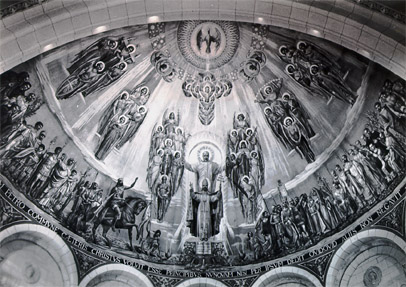
General View of the Abside "Fresco"
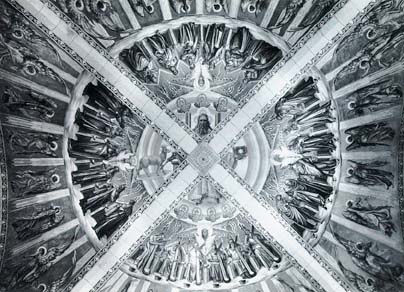
Vault transept -
Heaven according to the Vision of St. John in the Apocalypse
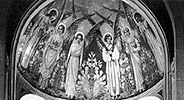
Side Altar
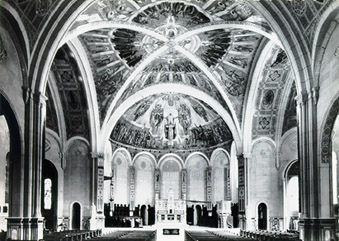
Interior View
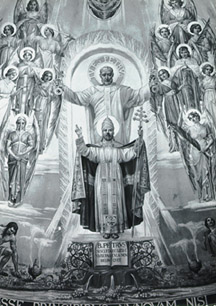
Abside Detail: St. Léon Inspired by St. Peter